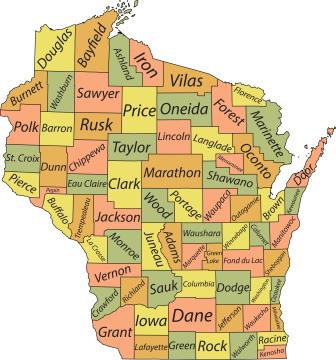Adult Protective Services (APS): Professionals
Wisconsin APS overview
The Wisconsin APS system is a county-led system of care. In this model, the county APS staff and Department of Health Services (DHS) APS staff have complimentary roles in ensuring adult protective services programs are available across the state. Wisconsin state statutes defines the roles of both the counties and the state in the delivery of the adult protective services system.
All counties respond to concerns of abuse, neglect, and financial exploitation of adults with disabilities ages 18–59 (referred to as adults at risk) and older adults ages 60 and over (referred to as elder adults at risk).
APS units are social services programs that are set up locally to carry out their statutory role by responding and intervening to concerns of abuse, neglect, and financial exploitation of adults and elder adults at risk. Some county APS units are part of an aging and disability resource center, while other APS units are part of county human services programs.
APS units located within Tribal nations work with the local Tribal partners to collectively respond to concerns of abuse, neglect and financial exploitation of Tribal members.
DHS's role in Wisconsin's APS system
DHS's APS unit is located within the Division of Public Health in the Bureau of Aging and Disability Resources. The main responsibility of this office is to provide leadership, coordination, and resources to the counties so they can effectively carry out APS functions. Additionally, DHS collects data on APS cases and program activities in Wisconsin through the web-based Wisconsin Reporting for Adult Protective Services (WRAPS) system. Questions for DHS staff can be sent to DHSAPS@dhs.wisconsin.gov.
Wisconsin APS data
Data is an important tool to understand the prevalence of abuse, neglect, and financial exploitation reported to APS units across Wisconsin. DHS provides a statewide web-based reporting system called Wisconsin Reporting System for Adult Protective Services (WRAPS).
County APS staff are statutorily required to enter data on APS reports received and the outcomes of APS investigations. Data in the Wisconsin reporting system is used to track APS program activities and trends across the state as well as advocate for policy changes as needed.
Annual and cumulative state APS data
- Wisconsin 2022 adult-at-risk APS data, P-00123 (PDF)
- Wisconsin 2022 elder-adult-at-risk APS data, P-00124 (PDF)
Counties' role in Wisconsin's APS system
County APS units receive and respond to reports of abuse, neglect, and financial exploitation of adults and elder adults at risk. Counties investigate APS reports and seek to link adults or elder adults at risk with services or protection. County APS units report their local data into the state reporting system for statewide data.
Resources for APS professionals
Wisconsin statutes
- §§46.2805–46.2895: Long-term care (ADRC and Family Care)
- §46.90: Elder abuse reporting system
- Chapter 50
- Subchapter I: Care and service residential facilities
- §50.06: Certain admissions to facilities (admission of an incapacitated person from hospital to facility)
- Subchapter VI: Hospices
- Chapter 51: State Alcohol, Drug Abuse, Developmental Disabilities and Mental Health Act
- Chapter 54: Guardianships and Conservatorships
- Chapter 55: Protective Service System
- Chapter 155: Power of Attorney for Health Care
- Chapter 244: Uniform Power of Attorney for Finances and Property
- §813.123: Restraining orders and injunctions for individuals at risk
Wisconsin administrative code
- Area Administration
- Division of Public Health (DPH)
- Division of Quality Assurance (DQA)
- Division of Medicaid Services (DMS)
- Ombudsman programs
- Ombudsman for older adults (60 years and older): Board on Aging and Long Term Care
- Ombudsman for adults with disabilities (18–59 years): Disability Rights Wisconsin

